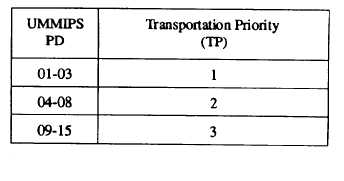| |
1.
2.
3.
4.
United States mail
Army and Navy vessels
Government air Service
Commercial carriers
a.
b.
c.
d.
e.
f.
g.
DEGREE
Rail freight
Air freight
Motor truck
Freight forwarders
Ships of United States registry
Ships of foreign registry
Small parcel carriers (e.g., USPS, Federal
Express).
OF PROTECTION
The degree of protection given or required for
packaging and packing to meet anticipated shipping
conditions. Protection levels are defined as Levels A,
B, and C. The level of packaging and packing of a
shipment is marked on exterior activities of the level
provided. An exterior containers in appropriate
combinations to inform the receiving activities of the
level provided. An exterior shipping container marked
C/C indicates the packaging (first letter) and packing
(second letter) are both Level C.
LEVEL A— The degree required to protect against
the most severe conditions that may be encountered
during shipment, handling, and storage.
LEVEL B—The degree required for protection when
the condition areto be less severe than those requiring Level
A, but more severe than time for which Level C is adequate.
LEVEL C—The degree required for protection
under known favorable conditions during shipment,
handling, and limited storage. Repairable must be
given Level C protection since guarded handling is
mandatory and the designated overhaul point is known.
TRANSPORTATION PRIORITIES
DOD Instruction 4410.6 established a Uniform
Material Movement and Issue Priority System
(UMMIPS) for the requisitioning and movement of
material within the DOD distribution system. The policy
and criteria established by UMMIPS for determining and
observing the priority of material movement by shipping
activities is implemented in DOD MILSTAMP
Regulation. Transportation priorities (TPs) and
movement criteria for material not covered by UMMIPS
are included in MILSTAMP for the purpose of
expressing uniformity of demands for transportation
service upon the Defense Transportation System (DTS).
The UMMIPS time standards imply that highspeed
transportation may be necessary to meet the
requirements of operating forces for high-priority
material demands (priority designators 01-08). Under
these conditions, the basic objective is to satisfy
customer demands on time, without operating and
transportation costs becoming an overriding factor.
Transportation priorities are normally assigned based
on the priority designator of the requirement being
shipped. Table 14-1 shows the relationship between
priority designators and transportation priorities.
TRANSPORTATION PRIORITIES WILL NOT BE
UPGRADED except by specific modification to original
supply demands. “EXPEDITED HANDLING”
shipments (UMMIPS priorities 01-03 with code ‘999”
indicated in the RDD field of the requisition) will be
afforded the highest precedence of handling prescribed in
this regulation, overriding all other priorities, projects, and
RDDs. In addition to the three TPs just mentioned TP4 is
used in MAC airlift for deferred airfreight on the basis as
authorized by MILSTAMP.
MILSTAMP AIR SHIPMENT
Air shipment within DTS is normally limited to
transportation priorities 1 and 2 (PD 01-08) shipments.
However, transportation priority 3 (PD 09-15)
shipments with advanced RDDs may qualify.
Naturally, air shipment would be used if it were more
economical or if surface transportation were not
available. The three major military airlift systems used
by the Navy are the Military Airlift Command (MAC),
QUICKTRANS, and Fleet Logistics Airlift System.
PACKAGING REPAIRABLE
The objectives of the mandatory turn-in repairable
program are to expedite the immediate return of
repairable, and to provide adequate packaging that will
Table 14-1.-Relationship Between UMMIPS Issue Priority
Designators (PD) and MILSTAMP Transportation Priorities (TP)
14-16
|

